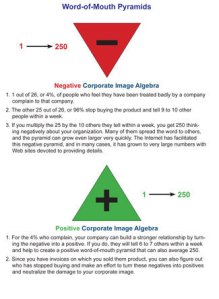Turning Customer Complaints Into a Powerful Marketing Machine
 The way companies handle complaints can mean the difference between success and failure in our increasingly competitive world. Businesses that turn complaints into opportunities for building closer relationships with customers are the ones that are most likely to survive and prosper.
The way companies handle complaints can mean the difference between success and failure in our increasingly competitive world. Businesses that turn complaints into opportunities for building closer relationships with customers are the ones that are most likely to survive and prosper.
Complaints are opportunities to build a stronger business
The complaint is a signal that should not be ignored. When customers complain, they are giving your company an opportunity to fix what is wrong and improve your business. Why? Customers act in their own self-interest, and they are in a unique position to tell your company the unvarnished truth — something your employees are unlikely to do because it might reflect negatively on their performance or they may fear that you might “kill the messenger” rather than listen to the message. Just about every comprehensive study done on this subject points to greater success for companies that turn the negatives represented by complaints into positives.
TARP Studies
John Goodman did pioneering customer service research through TARP, the company he founded in 1971. He showed that, while customer service is typically a cost center in most companies, it could be turned into a powerful marketing machine to drive sales, repeat business and greater profits. His research showed that roughly 4% of customers (1 out of 26) that were “wronged” by a company complain. The other 96% (25 out of 26, or the silent majority) stop buying and tell 9 to 10 others within a week about their poor treatment. This means that a negative word of mouth pyramid averaging 250 is created. If the company is able to satisfactorily solve the problems of the 4% that complain (turn the negative into a positive), they will tell 6 to 7 others within a week that the company solved their problem and this will result in a positive word of mouth pyramid of 250 customers that say good things about the company. The positive group will also develop a closer relationship with the company. What can you do about the other 96%? You can go through your customer list and contact customers that have not bought products from you in a while and ask them why you have not heard from them. This will identify a good number of negatives that you can turn into positives. And, in cases where there were no negatives, the contact is another opportunity to generate more business.
Marriott research
In their book, Turned On, Roger Dow and Susan Cook describe the Marriott research done to identify which guests intended to stay at the Marriott again. They divided guest stays into 3 groups A, B, and C.
A = Nothing bad happened during their stay.
B = Something bad happened, but Marriott fixed the problem.
C = Something bad happened, but Marriott did not fix the problem.
The percentage of these three groups that intended to return to the Marriott were as follows:
A = 89%
B = 94%
C = 69%
This corroborated the TARP studies that showed that a fixed relationship creates a more loyal customer than one that was never broken. The more a company is able to fix what is wrong, the more they build a positive reputation.
Opinion Research studies
Opinion Research did studies that showed that when choosing between similar products, 87% of customers choose the product from the company with the better reputation. Companies get better reputations by taking exceptionally good care of their customers. Bloomsberg Business Week recently compiled a list of the top 25 companies in customer service.
Develop a system to handle complaints and turn them into positive outcomes
How can your company use this information to turn complaints into a powerful marketing force that improves your business and reputation?
- Train you people to look for complaints and view them as opportunities to neutralize negatives and build stronger relationships with customers.
- Record the complaint so that it can be electronically distributed.
- Send it to the appropriate person or department with the authority to fix what is wrong.
- Make sure they fix it as quickly as possible.
- Follow up with the customer to insure that they were satisfied with the fix. If not, expedite a solution.
- Give them a code to use when they purchase from you again or refer others (you can give them an electronic coupon or code so that when they buy again or refer others they will get a discount).
- Track their repeat purchases and referrals.
- Report statistics on repeat purchases and referrals stemming from the fixed problem.
- Calculate the ROI (return on investment) of the entire process.
- Use positive results and customer quotations in your marketing communications (after getting permission).
How might you turn complaints into a marketing force to improve your business?
Ira Kalb is president of Kalb & Associates, an international consulting and training firm, and professor of marketing at the Marshall School of Business at University of Southern California (USC). He has won numerous awards for marketing and teaching, authored ten books and over 60 published articles, created marketing inventions that have made clients and students more successful. He is frequently interviewed by various media for his expertise in branding, crisis management and strategic marketing. Follow him on Twitter.
image courtesy of K&A Press from Nuts & Bolts Marketing by Ira S. Kalb
Explore posts in the same categories: Advertising, Branding, Corporate Image, Marketing, Marketing Information System, Uncategorized
Leave a comment